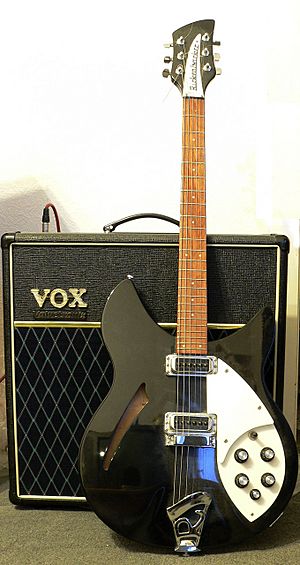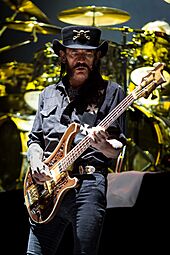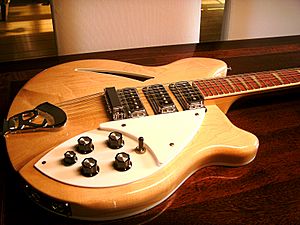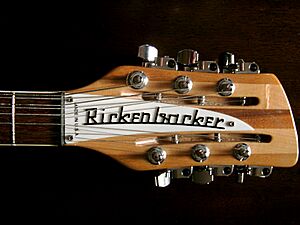Rickenbacker facts for kids
 |
|
| Private | |
| Industry | Musical instruments |
| Founded | 1931 |
| Founder | Adolph Rickenbacker George Beauchamp |
| Headquarters | , |
|
Area served
|
Worldwide |
|
Key people
|
Adolph Rickenbacker George Beauchamp |
| Products | Electric, acoustic, lap and console steel guitars, basses, amplifiers, electric violins, electric mandolins, electric banjos |
Rickenbacker International Corporation is a company in Santa Ana, California, USA. They make string instruments. Rickenbacker is famous for making the first electric guitars. They introduced an electric lap steel guitar in 1932. Today, they produce many types of electric guitars and bass guitars.
Contents
History of Rickenbacker Guitars
How the Company Started
In 1931, Adolph Rickenbacker and George Beauchamp started a company called Ro-Pat-In Corporation. This name came from "ElectRo-Patent-Instruments." Their goal was to sell electric lap steel guitars. Beauchamp worked with Paul Barth and Harry Watson to design these instruments. The company's brand name later became "Rickenbacker."
Their first instruments were nicknamed "Frying Pan" guitars. This was because they had long necks and small, round bodies. These were the first known solid body electric guitars. They had a special pickup with horseshoe-shaped magnets around the strings. Rickenbacker made thousands of these "frying pan" guitars until 1939.
The company also sold amplifiers to go with their guitars. These amps helped make the guitars louder. Famous engineer James B. Lansing designed the speaker for one of their professional models.
Early Electric Guitar Ideas
George Beauchamp was a performer who played violin and steel guitar. In the 1920s, he wanted to make his instrument louder so it could be heard over an orchestra. He first tried adding a phonograph-like horn to a guitar, but it didn't work well.
Later, he worked with inventor John Dopyera on guitars with metal resonators inside. These were called "National" guitars. Adolph Rickenbacker, a skilled engineer, helped make the metal bodies for these guitars.
As time went on, Beauchamp kept trying to make an electric guitar. He even built a test guitar from a piece of wood and an electric phonograph pickup. With help from Paul Barth, they created a working electric pickup. This pickup used horseshoe-shaped magnets that went around the strings. Harry Watson then built a wooden body and neck for this pickup. People called it the "fry-pan" because of its shape.
The First Electric Models
In late 1931, Beauchamp, Rickenbacker, and others formed the Ro-Pat-In Corporation. They wanted to make and sell electric musical instruments. Their first main product was the A-25 Hawaiian Guitar, also known as the "fry-pan" lap-steel electric guitar. They also made an Electric Spanish (standard) model and matching amplifiers.
By 1932, they started making the "Fry-Pan" guitars from cast aluminum. They also made some "Electro-Spanish" models from wood. These instruments were the start of the electric guitar because of their special pickups. In 1933, the company changed its name to Electro String Instrument Corporation. In 1934, they added "Rickenbacker" to the name to honor Adolph Rickenbacker.
Rickenbacker also made the Electro-Spanish Model B and the Electro-Spanish Ken Roberts guitars. The Ken Roberts model was special because it was the first guitar named after a musician who supported it. It also had a longer neck, making it easier to reach higher notes. This model was also the first to include a vibrato system, which lets players change the pitch of notes.
New Materials and Rock and Roll
In 1935, Rickenbacker introduced the Model "B" Electric Spanish guitar. This was another early solid-body electric guitar. Because the metal "Fry-Pans" could have tuning problems in hot places, many new models were made from Bakelite. This was an early type of plastic, like the material used in bowling balls.
Rickenbacker continued to focus on steel guitars until the 1950s. Then, in 1953, F.C. Hall bought the company. He changed the business to focus more on standard electric and acoustic guitars, especially with the rise of rock and roll.
In 1956, Rickenbacker introduced guitars with "neck through body" construction. This means the neck and the middle part of the body are made from one piece of wood. This design became a key feature for many Rickenbacker instruments, including the Combo 400 guitar and the Model 4000 bass.
In 1963, Rickenbacker created an electric twelve-string guitar. It had a clever headstock design that fit all twelve machine heads (tuning pegs) on a regular-sized headstock.
Rickenbacker and 1960s Rock and Roll
In the 1960s, Rickenbacker guitars became very popular thanks to the Beatles. In 1960, Beatles guitarist John Lennon bought a Rickenbacker 325. He used this guitar a lot in the early days of the band. He even played it during the Beatles' first appearance on The Ed Sullivan Show in 1964.
Rickenbacker sent Lennon two new 325s in 1964: a special 12-string model and an updated six-string model. Lennon used the newer six-string on the Beatles' second appearance on The Ed Sullivan Show.
Another Beatles guitarist, George Harrison, bought a 420 in 1963. In 1964, F.C. Hall of Rickenbacker gave Harrison a Rickenbacker 360/12. This was only the second electric twelve-string guitar Rickenbacker had built. This guitar became a big part of the Beatles' sound on their album A Hard Day's Night. Harrison continued to play this guitar throughout his life.
Later, in 1965, Harrison received another 360/12 guitar. He used this one on the song "If I Needed Someone" and during the Beatles' 1966 tours. This guitar was later stolen.
After the Beatles' 1965 summer tour, Paul McCartney often used a left-handed 1964 4001S FG Rickenbacker bass. This bass became popular with other bass players who liked McCartney's musical style. In 1967, McCartney gave his 4001 a colorful paint job. He used the Rickenbacker bass during his time with Wings and in his solo career, and still records with it today.
Because of the Beatles' fame, many other guitarists started using Rickenbackers. These included John Fogerty of Creedence Clearwater Revival, Paul Kantner of Jefferson Airplane, and John Entwistle and Pete Townshend of The Who. As the 1960s ended, Rickenbacker guitars became less popular for a while. However, Rickenbacker basses remained popular. In the late 1970s and early 1980s, Rickenbacker guitars became popular again with new wave and jangle pop bands because of their unique sound.
Special Features of Rickenbackers
Some Rickenbacker models have a special "Rick-O-Sound" output. This lets you send each pickup's sound to different amplifiers or effects. Another feature is the use of two truss rods in the neck. These help keep the neck straight and prevent it from twisting.
Rickenbacker guitars often have a neck made from several pieces of wood glued together. Their basses usually have a single piece of wood that goes through the whole body. Rickenbacker instruments are known for having narrower necks than many other guitars. They also have lacquered rosewood fingerboards, which give them a different feel.
Rickenbacker guitars are famous for their bright, ringing sound, often called "jangle" or "chime." Early models had "toaster pickups," which had a lower output. Later, in the late 1960s, they started using "high-gain pickups" that were twice as powerful. Many famous musicians have played Rickenbacker guitars, including Tom Petty, Mike Campbell, Peter Buck, Paul Weller, and Johnny Marr.
Rickenbacker Basses
The 4000 series were the first Rickenbacker bass guitars, introduced in 1957. They later made models like the 4001 (in 1961) and the 4003 (in 1979), which is still made today. They also made the 4005, a hollow-bodied bass, and special editions.
Rickenbacker basses have a very unique sound. The 4001 and 4003 basses are built with the "neck-through" design. This means the neck and the body are one solid piece of wood.
In the 1970s, the Rickenbacker bass became a favorite for progressive rock bands. Bassists like Mike Rutherford of Genesis and Chris Squire of Yes used them. Chris Squire was one of the first to use a Rickenbacker in stereo. He sent the bass signal to both a guitar amp and a bass amp, creating a powerful, grinding sound.

Other famous bassists who used Rickenbackers include Roger Glover of Deep Purple, Geddy Lee of Rush, and Cliff Burton of Metallica. Ian "Lemmy" Kilmister from Motörhead was also a big fan. Rickenbacker even made a special "Lemmy Kilmister" signature bass for him. More recently, they made a signature bass for Al Cisneros of Sleep and Om.
Rickenbacker basses were also popular in the UK punk and new wave music of the late 1970s and early 80s. Musicians like Glen Matlock of Sex Pistols, Paul Simonon of The Clash, and Peter Hook of Joy Division used them.
Acoustic Guitars
Rickenbacker has also made some unique acoustic guitars. While a few were sold in the 1950s, the company mostly focused on electric and steel guitars from the 1960s onward.
In 1995, Rickenbacker tried to bring back their acoustic guitars. They made several models, including six- and twelve-string versions. However, they stopped making acoustic guitars in 2006. After that, another luthier (guitar maker) was given a license to build Rickenbacker-branded acoustics until 2013.
Guitar Pickups
Rickenbacker makes three main types of pickups for their guitars:
- High-gain single-coil: These are standard on most modern models. They produce a powerful sound.
- Vintage Toaster single coil: These look like classic chrome toasters. They have a slightly lower output but create a brighter, cleaner sound. Many people think these are key to getting the classic "British Invasion" guitar sound.
- Humbucking: These pickups reduce hum and have a sound similar to some Gibson pickups. They are found on models like the Rickenbacker 650C and 4004 basses.
All three pickup designs can fit into most Rickenbacker models. The sound changes depending on the type of magnets and how much wire is wrapped around the pickup. Some vintage bass models also have "Horseshoe" pickups, which are similar to those on the very first "Frying Pan" guitars.
Protecting Their Brand
Rickenbacker is known for working hard to stop fake versions of their instruments from being sold.
See also
 In Spanish: Rickenbacker para niños
In Spanish: Rickenbacker para niños
- List of Rickenbacker players
- List of Rickenbacker products





